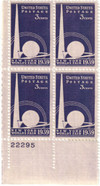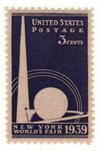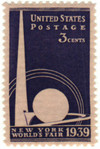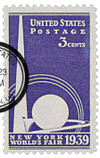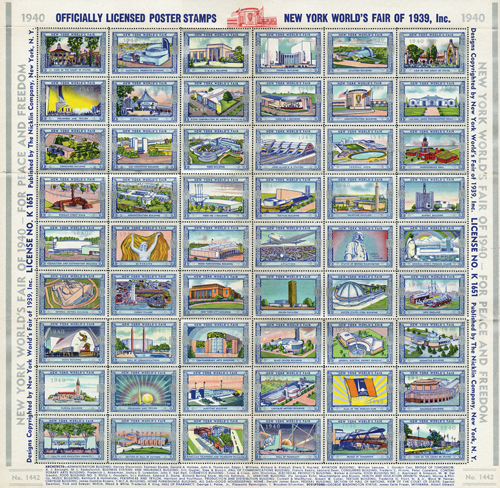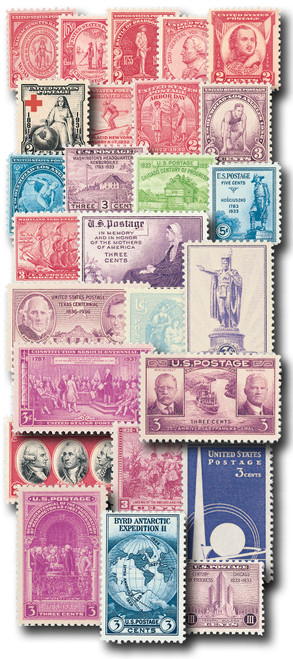
# 853 - 1939 3c New York World's Fair
1939 3¢ Trylon and Perisphere
First City: New York, New York
Quantity Issued: 101,699,550
Printed by: Bureau of Engraving and Printing
Printing Method: Rotary Press
Perforation: 10 ½ x 11
Color: Deep Purple
1939 New York World’s Fair
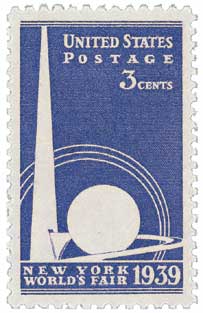
On April 30, 1939, the New York World’s Fair opened at Flushing Meadows-Corona Park in Queens, New York.
In 1935, a group of New York businessmen began planning an international exposition to lift the morale and sagging economy of the city, country and world during the Great Depression. The office for the World’s Fair Corporation was in the Empire State Building. Over the next four years, the fair and exhibits were planned, organized and built. It grew to be the largest international event since World War I.
To promote the fair, New York baseball teams the Brooklyn Dodgers, New York Giants, and New York Yankees wore special patches on their uniforms during the 1938 season. These patches featured the Trylon and Perisphere as well as “1939.” Additionally, Howard Hughes staged a round the world flight to promote the fair in other countries.
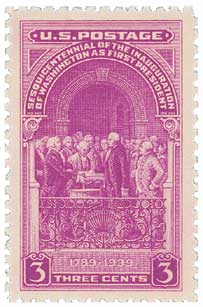
The fair’s Grand Opening was set for April 30, 1939, the 150th anniversary of George Washington’s first inauguration as president. By its Grand Opening, the fair covered over 1,200 acres of land at Flushing Meadows-Corona Park. A total of 206,000 people attended the grand opening.
One of the major features of the grand opening was the introduction of television to the American public by RCA. President Franklin Roosevelt’s opening remarks and other grand opening events were captured and displayed on RCA televisions. To show visitors how these televisions worked, special sets with transparent cases were made so they could see all the pieces at work inside.
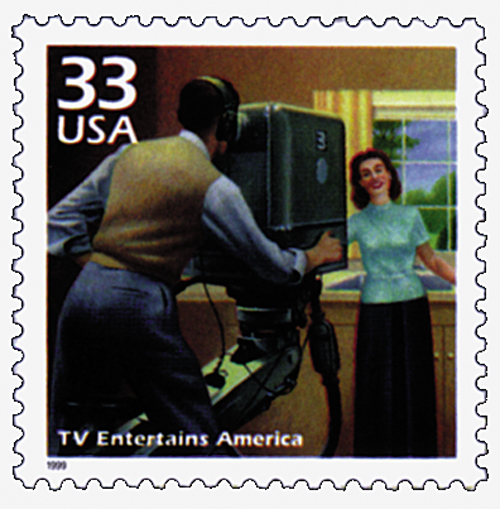
The RCA exhibit also included a camera that recorded visitors so they could see themselves on television. General Electric and Westinghouse also had televisions on display and the first televisions were made available for sale at New York City stores during the fair. Networks also began regular schedules of television broadcast by running the opening day ceremonies.
Two of the fair’s main features were the Trylon and Perisphere. The Trylon was a 700-foot-tall spire that was connected to the Perisphere – a sphere with a diameter of 180 feet. The Perisphere housed a “world of tomorrow” model city that could be viewed by visitors on a moving walkway.
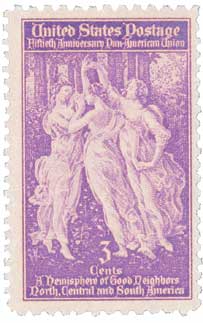
A total of 33 countries participated in the fair, whose theme was “World of Tomorrow” and the opening slogan was “Dawn of a New Day.” Among the new items introduced at the fair were Nylon fabric, the View-Master, and Scentovision. Other popular exhibits included Vermeer’s painting The Milkmaid, a streamlined pencil sharpener, a diner, a giant planetarium, and a keyboard-operated speech synthesizer. General Motors also unveiled Futurama, their vision of a city 20 years in the future that used a network of expressways.
In addition to introducing visitors to new ideas and materials, the World’s Fair promoted better relations between the US and Latin American countries. Known as the Good Neighbor Policy, the exposure to these countries tried to remove the negative stereotypes many Americans had of our Latin American neighbors.
One of the fair’s most popular exhibits was the Westinghouse Time Capsule, that wouldn’t be opened until 6939. Among the items placed in the tube were writings by Albert Einstein and Thomas Mann, copies of Life Magazine, a Mickey Mouse watch, a Gillette razor, a kewpie doll, money, a pack of Camel cigarettes, millions of pages of information on microfilm, and seeds for several common food crops. Westinghouse’s exhibit also included a seven-foot tall robot, Elektro the Moto-Man. 
On August 26, 1939, visitors to the fair were given a treat in the form of the first televised baseball game. W2XBS, which would become WNBC-TV, broadcast the game from Ebbets Field, where the Cincinnati Reds and Brooklyn Dodgers were playing. Team owners were afraid televising games would hurt attendance and ticket sales. But the television was the star exhibit at the fair, and promoters used the baseball game to show the potential of the new technology.
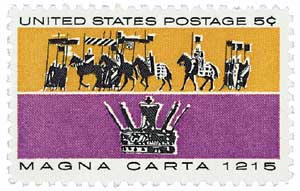
The fair ran for two seasons – April to October 1939 and 1940. The outbreak of World War II six months into the fair’s first season impacted several of the exhibits. In all, over 45 million people attended the fair. Many of the buildings were destroyed after the fair, though some were not and would be used again during the 1964-65 fair.
1939 3¢ Trylon and Perisphere
First City: New York, New York
Quantity Issued: 101,699,550
Printed by: Bureau of Engraving and Printing
Printing Method: Rotary Press
Perforation: 10 ½ x 11
Color: Deep Purple
1939 New York World’s Fair

On April 30, 1939, the New York World’s Fair opened at Flushing Meadows-Corona Park in Queens, New York.
In 1935, a group of New York businessmen began planning an international exposition to lift the morale and sagging economy of the city, country and world during the Great Depression. The office for the World’s Fair Corporation was in the Empire State Building. Over the next four years, the fair and exhibits were planned, organized and built. It grew to be the largest international event since World War I.
To promote the fair, New York baseball teams the Brooklyn Dodgers, New York Giants, and New York Yankees wore special patches on their uniforms during the 1938 season. These patches featured the Trylon and Perisphere as well as “1939.” Additionally, Howard Hughes staged a round the world flight to promote the fair in other countries.

The fair’s Grand Opening was set for April 30, 1939, the 150th anniversary of George Washington’s first inauguration as president. By its Grand Opening, the fair covered over 1,200 acres of land at Flushing Meadows-Corona Park. A total of 206,000 people attended the grand opening.
One of the major features of the grand opening was the introduction of television to the American public by RCA. President Franklin Roosevelt’s opening remarks and other grand opening events were captured and displayed on RCA televisions. To show visitors how these televisions worked, special sets with transparent cases were made so they could see all the pieces at work inside.

The RCA exhibit also included a camera that recorded visitors so they could see themselves on television. General Electric and Westinghouse also had televisions on display and the first televisions were made available for sale at New York City stores during the fair. Networks also began regular schedules of television broadcast by running the opening day ceremonies.
Two of the fair’s main features were the Trylon and Perisphere. The Trylon was a 700-foot-tall spire that was connected to the Perisphere – a sphere with a diameter of 180 feet. The Perisphere housed a “world of tomorrow” model city that could be viewed by visitors on a moving walkway.

A total of 33 countries participated in the fair, whose theme was “World of Tomorrow” and the opening slogan was “Dawn of a New Day.” Among the new items introduced at the fair were Nylon fabric, the View-Master, and Scentovision. Other popular exhibits included Vermeer’s painting The Milkmaid, a streamlined pencil sharpener, a diner, a giant planetarium, and a keyboard-operated speech synthesizer. General Motors also unveiled Futurama, their vision of a city 20 years in the future that used a network of expressways.
In addition to introducing visitors to new ideas and materials, the World’s Fair promoted better relations between the US and Latin American countries. Known as the Good Neighbor Policy, the exposure to these countries tried to remove the negative stereotypes many Americans had of our Latin American neighbors.
One of the fair’s most popular exhibits was the Westinghouse Time Capsule, that wouldn’t be opened until 6939. Among the items placed in the tube were writings by Albert Einstein and Thomas Mann, copies of Life Magazine, a Mickey Mouse watch, a Gillette razor, a kewpie doll, money, a pack of Camel cigarettes, millions of pages of information on microfilm, and seeds for several common food crops. Westinghouse’s exhibit also included a seven-foot tall robot, Elektro the Moto-Man. 
On August 26, 1939, visitors to the fair were given a treat in the form of the first televised baseball game. W2XBS, which would become WNBC-TV, broadcast the game from Ebbets Field, where the Cincinnati Reds and Brooklyn Dodgers were playing. Team owners were afraid televising games would hurt attendance and ticket sales. But the television was the star exhibit at the fair, and promoters used the baseball game to show the potential of the new technology.

The fair ran for two seasons – April to October 1939 and 1940. The outbreak of World War II six months into the fair’s first season impacted several of the exhibits. In all, over 45 million people attended the fair. Many of the buildings were destroyed after the fair, though some were not and would be used again during the 1964-65 fair.




